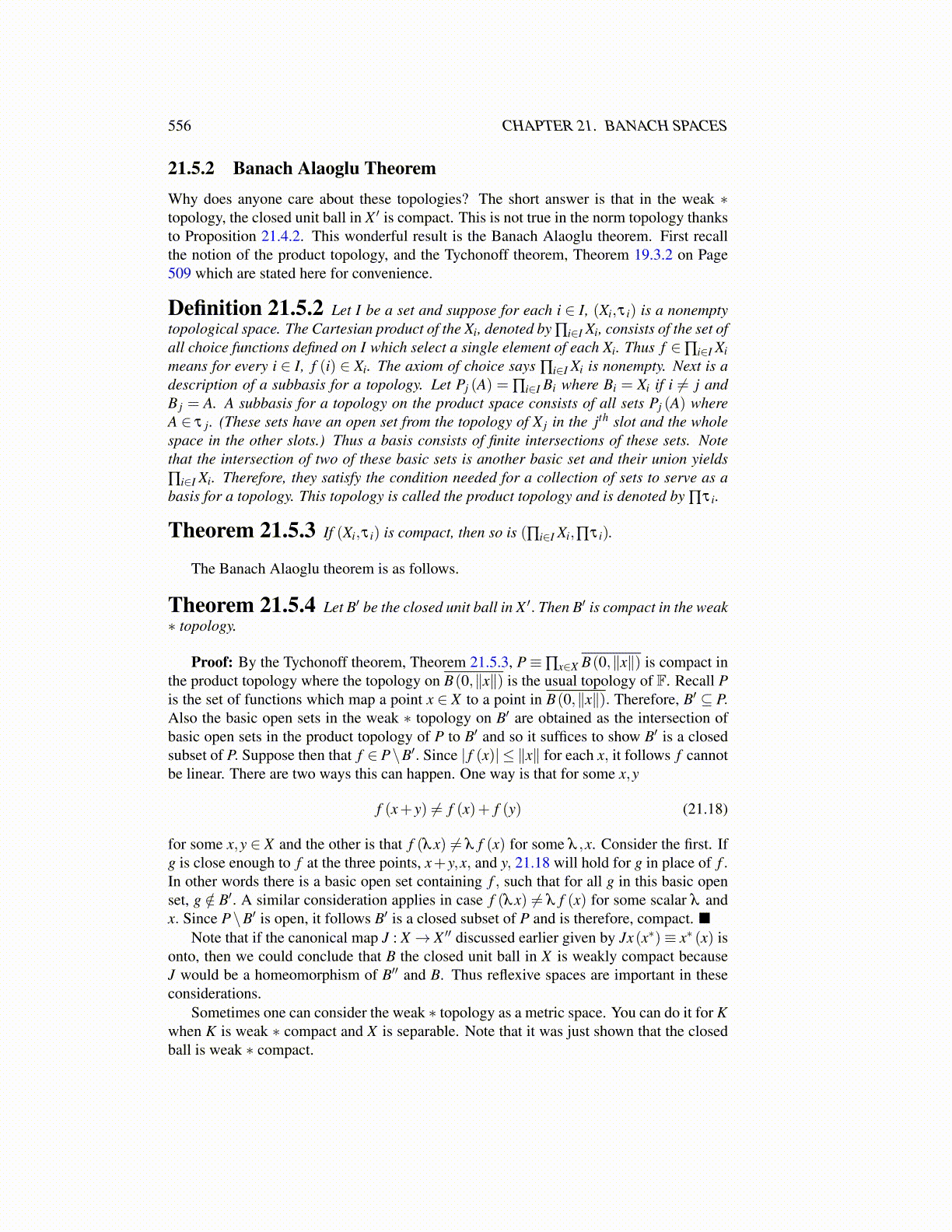
556 CHAPTER 21. BANACH SPACES
21.5.2 Banach Alaoglu TheoremWhy does anyone care about these topologies? The short answer is that in the weak ∗topology, the closed unit ball in X ′ is compact. This is not true in the norm topology thanksto Proposition 21.4.2. This wonderful result is the Banach Alaoglu theorem. First recallthe notion of the product topology, and the Tychonoff theorem, Theorem 19.3.2 on Page509 which are stated here for convenience.
Definition 21.5.2 Let I be a set and suppose for each i ∈ I, (Xi,τ i) is a nonemptytopological space. The Cartesian product of the Xi, denoted by ∏i∈I Xi, consists of the set ofall choice functions defined on I which select a single element of each Xi. Thus f ∈∏i∈I Ximeans for every i ∈ I, f (i) ∈ Xi. The axiom of choice says ∏i∈I Xi is nonempty. Next is adescription of a subbasis for a topology. Let Pj (A) = ∏i∈I Bi where Bi = Xi if i ̸= j andB j = A. A subbasis for a topology on the product space consists of all sets Pj (A) whereA ∈ τ j. (These sets have an open set from the topology of X j in the jth slot and the wholespace in the other slots.) Thus a basis consists of finite intersections of these sets. Notethat the intersection of two of these basic sets is another basic set and their union yields∏i∈I Xi. Therefore, they satisfy the condition needed for a collection of sets to serve as abasis for a topology. This topology is called the product topology and is denoted by ∏τ i.
Theorem 21.5.3 If (Xi,τ i) is compact, then so is (∏i∈I Xi,∏τ i).
The Banach Alaoglu theorem is as follows.
Theorem 21.5.4 Let B′ be the closed unit ball in X ′. Then B′ is compact in the weak∗ topology.
Proof: By the Tychonoff theorem, Theorem 21.5.3, P≡∏x∈X B(0,∥x∥) is compact inthe product topology where the topology on B(0,∥x∥) is the usual topology of F. Recall Pis the set of functions which map a point x ∈ X to a point in B(0,∥x∥). Therefore, B′ ⊆ P.Also the basic open sets in the weak ∗ topology on B′ are obtained as the intersection ofbasic open sets in the product topology of P to B′ and so it suffices to show B′ is a closedsubset of P. Suppose then that f ∈ P\B′. Since | f (x)| ≤ ∥x∥ for each x, it follows f cannotbe linear. There are two ways this can happen. One way is that for some x,y
f (x+ y) ̸= f (x)+ f (y) (21.18)
for some x,y ∈ X and the other is that f (λx) ̸= λ f (x) for some λ ,x. Consider the first. Ifg is close enough to f at the three points, x+y,x, and y, 21.18 will hold for g in place of f .In other words there is a basic open set containing f , such that for all g in this basic openset, g /∈ B′. A similar consideration applies in case f (λx) ̸= λ f (x) for some scalar λ andx. Since P\B′ is open, it follows B′ is a closed subset of P and is therefore, compact. ■
Note that if the canonical map J : X → X ′′ discussed earlier given by Jx(x∗)≡ x∗ (x) isonto, then we could conclude that B the closed unit ball in X is weakly compact becauseJ would be a homeomorphism of B′′ and B. Thus reflexive spaces are important in theseconsiderations.
Sometimes one can consider the weak ∗ topology as a metric space. You can do it for Kwhen K is weak ∗ compact and X is separable. Note that it was just shown that the closedball is weak ∗ compact.